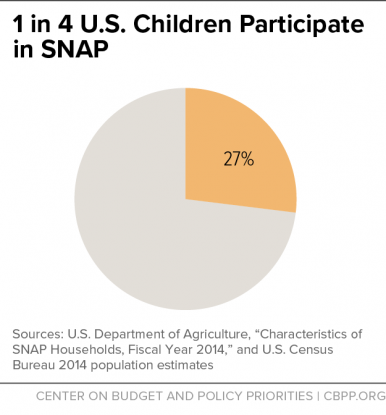The Supplemental Nutrition Assistance Program (SNAP) delivers more nutrition assistance to low-income children than any other federal program, making it the nation’s largest child nutrition program. In 2016, SNAP will help about 20 million children each month — about one in four U.S. children — while providing about $30 billion in nutrition benefits for children over the course of the year.[2] (See Figure 1.) While SNAP provides only a modest benefit — just $1.35 on average per person per meal for households with children — it forms a critical foundation for the health and well-being of America’s children, lifting millions of families and their children out of poverty and improving food security. Research shows that its support can have surprisingly important long-lasting effects.
Key Findings
- SNAP lifts millions of households out of poverty. SNAP kept about 10.3 million people out of poverty in 2012, including about 4.9 million children. SNAP lifted 2.1 million children out of deep poverty (defined as 50 percent of the poverty line), more than any other government assistance program.
- SNAP helps families put food on the table. Food insecurity — limited access to enough food for an active, healthy life — among children falls by roughly a third after their families receive SNAP benefits for six months. Giving families additional benefits during summer months when their children do not have access to free or reduced-price school meals also reduces the prevalence of very low food security among children — when some have to cut the size of meals, skip meals, or even go entire days without food — by about a third. SNAP’s benefits are concentrated among those with the greatest need.
- SNAP helps improve child health. Mothers exposed to SNAP (then called food stamps) during pregnancy as the program gradually expanded nationwide in the 1960s and early 1970s gave birth to fewer low birth-weight babies. Some evidence suggests that children receiving SNAP are less likely than low-income non-participants to be in fair or poor health or underweight, and their families are less likely to trade off paying for health care and paying for other basic needs, like food, housing, heating, and electricity.
- Children who receive SNAP do better in school. Access to an adequate, healthy diet during early childhood is essential to developing the skills crucial for school success, including memory, emotional stability, and social skills. SNAP participation can lead to improvements in reading and mathematics skills among elementary children, especially young girls, and increase the chances of graduating from high school.
- Early access to SNAP can improve long-term health and economic outcomes. Adults who had access to SNAP as young children reported better health and had lower rates of “metabolic syndrome” (a combined measure of the incidence of obesity, high blood pressure, heart disease, and diabetes), and women who had access to food stamps as young children reported improved economic self-sufficiency (as measured by a combination of employment, income, poverty status, high school graduation, and program participation).




